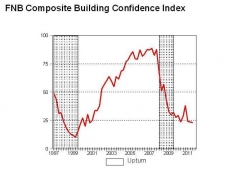FNB building confidence steady in 3Q20112011-09-29 By Cees Bruggemans, Chief Economist FNB Cees@fnb.co.za 28 September 2011 • The FNB/BER building confidence index remained almost unchanged at 23. This is the third consecutive quarter that confidence remained static at this low level. • The uptick in residential building activity waned, but that of non-residential activity carried on in 3Q11. • Increased investor uncertainty following renewed sharp falls in global share markets and economic growth downgrades at best point to continued weakness in the building industry in the next quarter or so. • Constrained credit conditions, despite the low interest rate, and oversupply continued to hamper the building trade. The FNB/BER building confidence index came in at 23 in 3Q2011 compared to 24 in 2Q2011. The latest reading indicates that building confidence remained steady for all practical purposes. On average three quarters of respondents in different sectors of the building industry continued to rate prevailing business conditions as unsatisfactory. The FNB/BER building confidence index can vary between zero (indicating an extreme lack of confidence) and 100 (indicating extreme confidence). It reveals the percentage of respondents that are satisfied with prevailing business conditions in six sectors, namely architects, quantity surveyors, building contractors, building sub-contractors (plumbers, electricians, carpenters and shop fitters), manufacturers of building materials (cement, bricks and glass) and retailers of building material and hardware. In contrast to the RMB/BER BCI, which includes only main contractors, the FNB/BER building confidence index covers the whole pipeline, from planning (represented by the architects and quantity surveyors), renovation, additions, the informal sector (represented by building material merchants) and production (manufacturers of building materials) to the actual construction of buildings by main contractors and sub-contractors. In 3Q2011 the composite building confidence index remained steady, as changes in the constituent parts cancelled each other out. The confidence of quantity surveyors, sub-contractors and building material merchants increased, while that of architects, main contractors and building material manufacturers declined relative to 2Q2011. "Too much should not be read into the 3Q2011 increase of sub-contractors and merchants, as well as the decline of manufacturers, as a longer term perspective reveals that in these cases confidence mostly reversed to their 1Q2011 levels". The almost steady (moving from 21 in 2Q2011 to 20 in 3Q2011) confidence of all main contractors hides the fact that the situation of residential contractors diverged from that of non-residential contractors. After a long period of (year-on-year) contraction, residential building activity finally picked up in 2Q2011. However, the BER survey indicates that this uptick did not continue in 3Q2011. Residential building confidence declined from 24 to 21 (the same level as in 1Q2011), as the growth in building activity faltered once more. This unfavourable development could largely be attributed to the fact that contractors focussing on the high end market (i.e. buildings of R500 000 and more) continued to face difficult times due to oversupply and weak effective demand (due to tight bank credit conditions). Contractors focussing on the affordable market (i.e. between R300 000 and R500 000) also faced weak effective demand, but no oversupply. In contrast, non-residential building confidence increased from 16 to 21. Although still very low, the rise in confidence can partly be attributed to the fact that the uptick in non-residential building activity registered in 2Q2011 was sustained in 3Q2011. This uptick stems primarily from some private sector work (such as the refitting of older office blocks to upgrade them and the building of shopping centres in non-metropolitan areas) and some government work (such as the school and hospital building programme of some provinces). The recovery is therefore not yet broad based, where all types of new non-residential buildings (such as shopping centres, warehousing and industrial space) are erected. Main contractors saw profitability decline at a slower pace for the first time in a year. Residential contractors reported a further increase in tendering competition, reflecting their fall of activity. Tendering competition remained fierce, but steady, in the case of non-residential contractors even as their activity levels rose somewhat. The confidence of sub-contractors recovered in 2009, but has remained static at a low level of about 35 since the beginning of 2010. After falling temporarily from 36 in 2Q2011 to 23 in 2Q2011, the confidence of sub-contractors bounced back to 34 in 3Q2011. The low level of confidence is consistent with very weak activity levels. Whereas residential sub-contractors saw activity remaining unchanged, non-residential sub-contractors saw a further decline relative to 2Q2011. After averaging 40 in 2010, the confidence of architects shifted downwards to 25 in 2011. The confidence of quantity surveyors had almost the exact opposite pattern. Both professions saw some sketch work and drawings coming through, but little of it converted to contract awards in 3Q11. The confidence of building material merchants only partially corrected after it plunged to almost zero in 2Q2011. At 17, confidence remained very low, reflecting extremely poor trading conditions, as the oversupply of trading space remained high. The confidence of building material manufacturers reverted to the same low level as in 1Q2011 mainly due to the lethal combination of costs rising faster than selling prices. Sales also performed poorer in 3Q2011 compared to 2Q2011. In conclusion: The building industry has moved from a situation of free fall in 2009 and 2010 to one characterised by some isolated, temporary pockets of stronger activity in 2011. However, the tentative signs of recovery in the residential sector in 2Q2011 waned in 3Q2011, but those in the non-residential sector carried on. Increased investor uncertainty following renewed sharp falls in global share markets and economic growth downgrades at best point to continued weakness in the building industry in the next quarter or so. Constrained credit conditions, despite the low interest rate, and oversupply continued to hamper the building trade. Visit FNB Economics website www.fnb.co.za/economics Click here to navigate to the online version now. |
FNB building confidence steady in 3Q2011
Copyright © 2024 KwaZulu-Natal Top Business
